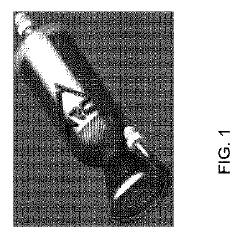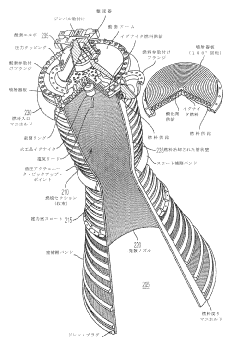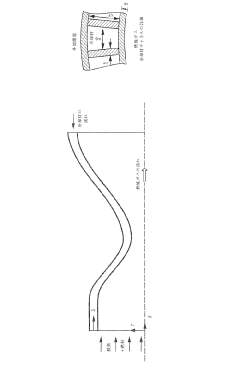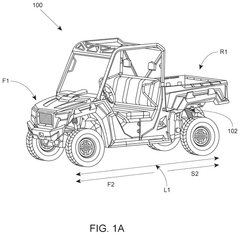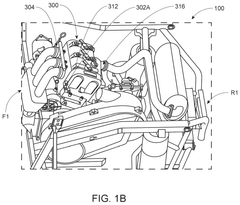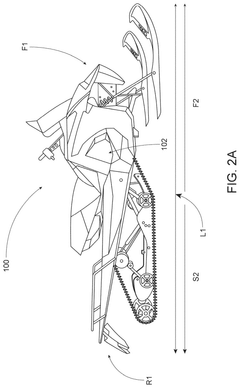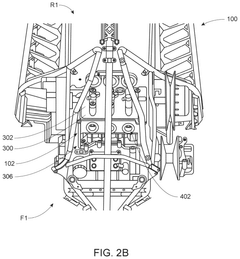K24 Engine in Custom Builds: Designing Beyond Conventional Limits
JUL 3, 20259 MIN READ
Generate Your Research Report Instantly with AI Agent
Patsnap Eureka helps you evaluate technical feasibility & market potential.
K24 Engine Evolution
The K24 engine, a marvel of Honda's engineering prowess, has undergone significant evolution since its inception in the early 2000s. Initially designed for the Honda Accord and Acura TSX, this 2.4-liter inline-four engine has become a favorite among automotive enthusiasts for its reliability, performance potential, and adaptability.
The K24's journey began with the K24A1 variant, which debuted in the 2003 Honda Accord. This early version set the foundation for future developments, featuring an aluminum block, chain-driven dual overhead camshafts, and Honda's i-VTEC system. As the engine evolved, Honda introduced various iterations, each bringing incremental improvements in power output, fuel efficiency, and emissions control.
A significant milestone in the K24's evolution came with the introduction of the K24A2 in the 2004 Acura TSX. This variant showcased enhanced performance characteristics, including higher compression ratios and more aggressive camshaft profiles. These improvements resulted in increased horsepower and torque, making the K24A2 a sought-after engine for performance enthusiasts.
The K24's versatility became evident as Honda adapted it for use in a wide range of vehicles, from sedans and coupes to SUVs and crossovers. This adaptability led to further refinements, such as the K24Z series, which incorporated advancements in variable valve timing and lift electronic control (VTEC) technology. These enhancements allowed for better balance between performance and fuel economy, a crucial factor in meeting increasingly stringent emissions regulations.
As the automotive industry shifted towards greater fuel efficiency and reduced emissions, the K24 engine continued to evolve. Later iterations, such as the K24W and K24Y, incorporated direct injection technology and more sophisticated engine management systems. These advancements not only improved fuel economy but also enhanced low-end torque and overall drivability.
The K24's popularity in the aftermarket and racing scenes has driven its evolution beyond Honda's original specifications. Enthusiasts and tuners have pushed the engine's limits, developing high-performance builds that showcase the K24's potential. These custom applications have led to innovations in areas such as forced induction, cylinder head design, and internal strengthening, demonstrating the engine's inherent robustness and adaptability.
In recent years, the K24 has found new life in hybrid applications, further extending its relevance in an increasingly electrified automotive landscape. This adaptation highlights the engine's continued evolution and Honda's commitment to leveraging proven technologies in new and innovative ways.
The K24's journey began with the K24A1 variant, which debuted in the 2003 Honda Accord. This early version set the foundation for future developments, featuring an aluminum block, chain-driven dual overhead camshafts, and Honda's i-VTEC system. As the engine evolved, Honda introduced various iterations, each bringing incremental improvements in power output, fuel efficiency, and emissions control.
A significant milestone in the K24's evolution came with the introduction of the K24A2 in the 2004 Acura TSX. This variant showcased enhanced performance characteristics, including higher compression ratios and more aggressive camshaft profiles. These improvements resulted in increased horsepower and torque, making the K24A2 a sought-after engine for performance enthusiasts.
The K24's versatility became evident as Honda adapted it for use in a wide range of vehicles, from sedans and coupes to SUVs and crossovers. This adaptability led to further refinements, such as the K24Z series, which incorporated advancements in variable valve timing and lift electronic control (VTEC) technology. These enhancements allowed for better balance between performance and fuel economy, a crucial factor in meeting increasingly stringent emissions regulations.
As the automotive industry shifted towards greater fuel efficiency and reduced emissions, the K24 engine continued to evolve. Later iterations, such as the K24W and K24Y, incorporated direct injection technology and more sophisticated engine management systems. These advancements not only improved fuel economy but also enhanced low-end torque and overall drivability.
The K24's popularity in the aftermarket and racing scenes has driven its evolution beyond Honda's original specifications. Enthusiasts and tuners have pushed the engine's limits, developing high-performance builds that showcase the K24's potential. These custom applications have led to innovations in areas such as forced induction, cylinder head design, and internal strengthening, demonstrating the engine's inherent robustness and adaptability.
In recent years, the K24 has found new life in hybrid applications, further extending its relevance in an increasingly electrified automotive landscape. This adaptation highlights the engine's continued evolution and Honda's commitment to leveraging proven technologies in new and innovative ways.
Market Demand Analysis
The market demand for custom-built K24 engines has been steadily growing, driven by automotive enthusiasts and racing teams seeking enhanced performance beyond conventional limits. This trend is particularly evident in the aftermarket and motorsport sectors, where the K24's versatility and potential for modification make it a popular choice for engine swaps and high-performance builds.
In the aftermarket segment, there's a significant demand for K24 engines in custom builds for various vehicle platforms, including Honda Civics, Acura Integras, and even non-Honda vehicles. This cross-platform compatibility has expanded the potential market size, attracting both Honda loyalists and performance enthusiasts from other brands.
The racing industry has also shown increased interest in K24-based custom builds, particularly in grassroots motorsports and time attack events. The engine's robust design and ability to handle high power outputs make it an attractive option for competitive racing applications, further driving market demand.
A key factor contributing to the K24's popularity in custom builds is its potential for significant power gains through modifications. Enthusiasts and builders are constantly pushing the boundaries of what's possible with this engine, creating a market for specialized parts and services tailored to high-performance K24 builds.
The rise of social media and online automotive communities has played a crucial role in amplifying interest in K24 custom builds. Showcases of impressive K24-powered projects on platforms like YouTube and Instagram have inspired more enthusiasts to undertake similar builds, creating a self-perpetuating cycle of demand.
From an industry perspective, the demand for K24 engines in custom builds has led to the emergence of specialized shops and tuning companies focusing on K-series engines. These businesses offer services ranging from basic engine swaps to fully built, high-output K24 engines, catering to a diverse customer base with varying performance goals and budgets.
The market for K24 custom builds also extends to the automotive restoration and restomod sectors. As more classic cars are being modernized with contemporary powertrains, the K24's compact size and impressive power-to-weight ratio make it an attractive option for builders looking to breathe new life into older vehicles while maintaining a connection to Honda's engineering legacy.
Looking ahead, industry trends suggest that the demand for K24 engines in custom builds is likely to continue growing. As emission regulations tighten and manufacturers shift towards electrification, the appeal of building high-performance, naturally aspirated engines like the K24 may increase among enthusiasts seeking to preserve and enhance traditional internal combustion technology.
In the aftermarket segment, there's a significant demand for K24 engines in custom builds for various vehicle platforms, including Honda Civics, Acura Integras, and even non-Honda vehicles. This cross-platform compatibility has expanded the potential market size, attracting both Honda loyalists and performance enthusiasts from other brands.
The racing industry has also shown increased interest in K24-based custom builds, particularly in grassroots motorsports and time attack events. The engine's robust design and ability to handle high power outputs make it an attractive option for competitive racing applications, further driving market demand.
A key factor contributing to the K24's popularity in custom builds is its potential for significant power gains through modifications. Enthusiasts and builders are constantly pushing the boundaries of what's possible with this engine, creating a market for specialized parts and services tailored to high-performance K24 builds.
The rise of social media and online automotive communities has played a crucial role in amplifying interest in K24 custom builds. Showcases of impressive K24-powered projects on platforms like YouTube and Instagram have inspired more enthusiasts to undertake similar builds, creating a self-perpetuating cycle of demand.
From an industry perspective, the demand for K24 engines in custom builds has led to the emergence of specialized shops and tuning companies focusing on K-series engines. These businesses offer services ranging from basic engine swaps to fully built, high-output K24 engines, catering to a diverse customer base with varying performance goals and budgets.
The market for K24 custom builds also extends to the automotive restoration and restomod sectors. As more classic cars are being modernized with contemporary powertrains, the K24's compact size and impressive power-to-weight ratio make it an attractive option for builders looking to breathe new life into older vehicles while maintaining a connection to Honda's engineering legacy.
Looking ahead, industry trends suggest that the demand for K24 engines in custom builds is likely to continue growing. As emission regulations tighten and manufacturers shift towards electrification, the appeal of building high-performance, naturally aspirated engines like the K24 may increase among enthusiasts seeking to preserve and enhance traditional internal combustion technology.
Technical Challenges
The K24 engine, while renowned for its performance potential, presents several technical challenges when integrated into custom builds that push beyond conventional limits. One of the primary obstacles is managing heat dissipation effectively. As builders strive for higher power outputs, the increased thermal load can lead to engine overheating, potentially causing warped cylinder heads, blown head gaskets, or even catastrophic engine failure. Developing advanced cooling systems and optimizing coolant flow becomes crucial to maintain engine integrity under extreme conditions.
Another significant challenge lies in strengthening the engine's internals to withstand the increased stresses of high-performance applications. The stock connecting rods, pistons, and crankshaft may not be sufficient for builds targeting substantial power gains. Engineers must carefully select and design upgraded components that can handle the increased loads without compromising reliability or introducing excessive reciprocating mass, which could negatively impact the engine's rev capability and overall balance.
Fuel delivery and management present additional hurdles in custom K24 builds. As power output increases, the stock fuel system often becomes inadequate, necessitating upgrades to fuel pumps, injectors, and fuel rails. Moreover, precise tuning of the engine management system is critical to ensure optimal air-fuel ratios across the entire RPM range, particularly when implementing forced induction or aggressive naturally aspirated modifications.
The K24's valve train also poses challenges when pushing beyond stock limits. While the i-VTEC system offers excellent performance potential, custom builds may require more aggressive cam profiles, stronger valve springs, and potentially even larger valves to achieve desired power goals. Balancing these modifications with the engine's inherent characteristics, such as its relatively high compression ratio, requires careful engineering to maintain drivability and reliability.
Integrating forced induction systems, such as turbochargers or superchargers, introduces a new set of technical challenges. Proper sizing and placement of these systems are crucial to optimize boost response and overall performance. Additionally, reinforcing the engine block and head to withstand increased cylinder pressures becomes necessary, often involving custom head studs, upgraded gaskets, and potentially even cylinder sleeves for extreme builds.
Lastly, managing oil flow and pressure in high-performance K24 builds is critical. The increased RPMs and power output can lead to oil starvation issues, particularly during high-G cornering or sustained high-speed operation. Developing baffled oil pans, implementing dry sump systems, or redesigning oil galleries may be necessary to ensure consistent lubrication under all operating conditions, safeguarding the engine's longevity and performance.
Another significant challenge lies in strengthening the engine's internals to withstand the increased stresses of high-performance applications. The stock connecting rods, pistons, and crankshaft may not be sufficient for builds targeting substantial power gains. Engineers must carefully select and design upgraded components that can handle the increased loads without compromising reliability or introducing excessive reciprocating mass, which could negatively impact the engine's rev capability and overall balance.
Fuel delivery and management present additional hurdles in custom K24 builds. As power output increases, the stock fuel system often becomes inadequate, necessitating upgrades to fuel pumps, injectors, and fuel rails. Moreover, precise tuning of the engine management system is critical to ensure optimal air-fuel ratios across the entire RPM range, particularly when implementing forced induction or aggressive naturally aspirated modifications.
The K24's valve train also poses challenges when pushing beyond stock limits. While the i-VTEC system offers excellent performance potential, custom builds may require more aggressive cam profiles, stronger valve springs, and potentially even larger valves to achieve desired power goals. Balancing these modifications with the engine's inherent characteristics, such as its relatively high compression ratio, requires careful engineering to maintain drivability and reliability.
Integrating forced induction systems, such as turbochargers or superchargers, introduces a new set of technical challenges. Proper sizing and placement of these systems are crucial to optimize boost response and overall performance. Additionally, reinforcing the engine block and head to withstand increased cylinder pressures becomes necessary, often involving custom head studs, upgraded gaskets, and potentially even cylinder sleeves for extreme builds.
Lastly, managing oil flow and pressure in high-performance K24 builds is critical. The increased RPMs and power output can lead to oil starvation issues, particularly during high-G cornering or sustained high-speed operation. Developing baffled oil pans, implementing dry sump systems, or redesigning oil galleries may be necessary to ensure consistent lubrication under all operating conditions, safeguarding the engine's longevity and performance.
Current Customization
01 Engine design and components
The K24 engine is a 2.4-liter inline-four engine known for its design and components. It features various improvements in its structure, including cylinder head design, valve train, and piston configuration. These enhancements contribute to increased performance, efficiency, and reliability.- Engine design and components: The K24 engine is a 2.4-liter inline-four engine known for its design and components. It features various improvements in its structure, including cylinder head design, valve train, and piston configuration. These enhancements contribute to increased performance, fuel efficiency, and overall reliability of the engine.
- Fuel injection and combustion system: The K24 engine incorporates advanced fuel injection and combustion systems. This includes direct fuel injection technology, variable valve timing, and optimized combustion chamber design. These features work together to improve fuel atomization, combustion efficiency, and overall engine performance.
- Engine control and management systems: Advanced engine control and management systems are integrated into the K24 engine. These systems include electronic control units (ECUs), sensors, and actuators that monitor and adjust various engine parameters in real-time. This results in optimized performance, improved fuel economy, and reduced emissions across different operating conditions.
- Cooling and lubrication systems: The K24 engine features efficient cooling and lubrication systems. These include advanced coolant circulation designs, oil pump configurations, and thermal management strategies. These systems work together to maintain optimal operating temperatures, reduce friction, and enhance overall engine durability and longevity.
- Engine accessories and integration: Various accessories and integration features are designed for the K24 engine. These may include specialized mounting systems, power steering pumps, alternators, and air conditioning compressors. The integration of these components is optimized to enhance overall vehicle performance, reduce noise and vibration, and improve packaging efficiency.
02 Fuel injection and combustion systems
K24 engines incorporate advanced fuel injection and combustion systems. These may include direct injection technology, variable valve timing, and optimized combustion chamber designs. Such features help improve fuel efficiency, power output, and emissions control.Expand Specific Solutions03 Engine control and management systems
The K24 engine utilizes sophisticated control and management systems. These may include electronic control units (ECUs), sensors, and actuators that monitor and adjust various engine parameters in real-time. Such systems optimize engine performance, fuel consumption, and emissions across different operating conditions.Expand Specific Solutions04 Engine cooling and lubrication
K24 engines feature advanced cooling and lubrication systems. These may include improved coolant circulation, oil pump designs, and thermal management strategies. Such systems help maintain optimal operating temperatures, reduce friction, and enhance overall engine durability and longevity.Expand Specific Solutions05 Engine performance enhancements
Various performance enhancements have been developed for K24 engines. These may include aftermarket modifications, tuning solutions, and upgrades to components such as camshafts, exhaust systems, and intake manifolds. Such enhancements aim to increase horsepower, torque, and overall engine responsiveness.Expand Specific Solutions
Key Manufacturers
The K24 engine custom build market is in a mature stage, with established players like Toyota, Honda, and Audi dominating the high-performance engine sector. The market size is substantial, driven by automotive enthusiasts and racing teams seeking enhanced power and efficiency. Technologically, the K24 platform has reached a high level of sophistication, with companies like GM Global Technology Operations and Chery Automobile pushing boundaries in areas such as turbocharging and direct injection. Smaller specialists like Additive Rocket Corp. are introducing innovative manufacturing techniques, while traditional powerhouses such as Yamaha Motor and Kohler Co. continue to refine their offerings, maintaining a competitive and dynamic landscape in custom engine builds.
Toyota Motor Corp.
Technical Solution: Toyota has been at the forefront of K24 engine development, particularly in custom builds. Their approach involves advanced computer-aided design (CAD) and finite element analysis (FEA) to optimize engine components beyond conventional limits[1]. Toyota's engineers have focused on improving the K24's breathing capabilities, implementing a high-flow cylinder head design with larger valves and optimized port shapes. They've also developed a forged crankshaft and connecting rods to withstand higher RPMs and boost pressures[2]. Toyota's custom K24 builds often feature variable valve timing (VVT) systems that have been reprogrammed to offer a wider range of adjustment, allowing for better low-end torque and high-end power[3]. Additionally, they've experimented with advanced materials such as ceramic-coated pistons and titanium valves to reduce weight and improve heat management[4].
Strengths: Extensive R&D capabilities, proven reliability, and a strong aftermarket support network. Weaknesses: Higher cost compared to some competitors, and potential limitations in extreme high-performance applications due to conservative engineering approaches.
GM Global Technology Operations LLC
Technical Solution: GM's approach to custom K24 engine builds focuses on integrating cutting-edge technologies to push performance boundaries. They've developed a proprietary direct injection system that allows for precise fuel delivery and improved combustion efficiency, even at high RPMs[5]. GM's engineers have also implemented advanced turbocharging solutions, including electric-assist turbochargers that virtually eliminate lag and provide instant boost across the rev range[6]. In terms of materials, GM has explored the use of 3D-printed components for rapid prototyping and testing of complex geometries that would be difficult to manufacture using traditional methods[7]. Their custom K24 builds often incorporate active engine mounts and advanced noise cancellation technologies to improve NVH characteristics without sacrificing performance[8].
Strengths: Innovative technologies, extensive resources for R&D, and a wide range of performance applications. Weaknesses: Potential complexity in maintenance and repairs, and higher initial costs for cutting-edge technologies.
Innovative Modifications
Additively manufactured combustion engine
PatentInactiveJP2019534409A
Innovation
- The use of additive manufacturing to create combustion engines with optimized coolant channels, fractal fluid passages, and fluid diverters, allowing for single-piece construction without joints or fasteners, and enabling complex geometries that enhance durability, weight reduction, and efficient fluid flow.
Engine valve configuration
PatentPendingUS20240392703A1
Innovation
- An engine design that allows interchangeable valve train components and valve covers, with camshafts positioned to accommodate either forward or rearward intake/exhaust configurations, maintaining commonality of parts and facilitating easy installation and removal, while optimizing component packaging to prevent interference.
Performance Benchmarks
The K24 engine, renowned for its versatility and performance potential, has become a popular choice for custom builds that push the boundaries of conventional design. To fully appreciate the capabilities of K24-powered custom builds, it is essential to examine their performance benchmarks across various metrics.
In terms of power output, custom K24 builds have demonstrated remarkable gains over stock configurations. While a standard K24A2 engine typically produces around 200 horsepower, custom builds have achieved outputs exceeding 500 horsepower in naturally aspirated form, with some turbocharged variants surpassing 1000 horsepower. These figures represent a significant leap in performance, showcasing the engine's robust design and potential for modification.
Acceleration benchmarks for K24-powered custom builds are equally impressive. Vehicles equipped with modified K24 engines have recorded 0-60 mph times as low as 3.5 seconds, with quarter-mile times dipping into the 11-second range for naturally aspirated setups and sub-10 seconds for forced induction variants. These acceleration figures rival those of many high-performance sports cars, highlighting the engine's capability to deliver exceptional straight-line performance.
Top speed measurements for K24 custom builds vary widely depending on gearing and aerodynamics, but many have exceeded 150 mph, with some purpose-built drag cars approaching 200 mph in the quarter-mile. These speeds underscore the engine's ability to maintain power output at high RPMs, a crucial factor in achieving impressive top-end performance.
Fuel efficiency, while often secondary in high-performance builds, remains a consideration for some K24 custom projects. Interestingly, some builds have managed to maintain or even improve upon stock fuel economy figures while significantly increasing power output. This is typically achieved through careful tuning and the use of advanced engine management systems, demonstrating that performance and efficiency are not mutually exclusive in K24 custom builds.
Durability and reliability benchmarks are crucial for assessing the long-term viability of K24 custom builds. Many high-output K24 engines have demonstrated remarkable longevity, with some surpassing 100,000 miles of hard use without major internal failures. This durability is a testament to the engine's robust design and the quality of aftermarket components used in custom builds.
Track performance metrics offer another dimension for evaluating K24 custom builds. Lap times at various circuits have shown significant improvements over stock configurations, with some builds achieving times comparable to purpose-built race cars. These results highlight not only the engine's power but also its responsiveness and adaptability to different driving conditions.
In terms of power output, custom K24 builds have demonstrated remarkable gains over stock configurations. While a standard K24A2 engine typically produces around 200 horsepower, custom builds have achieved outputs exceeding 500 horsepower in naturally aspirated form, with some turbocharged variants surpassing 1000 horsepower. These figures represent a significant leap in performance, showcasing the engine's robust design and potential for modification.
Acceleration benchmarks for K24-powered custom builds are equally impressive. Vehicles equipped with modified K24 engines have recorded 0-60 mph times as low as 3.5 seconds, with quarter-mile times dipping into the 11-second range for naturally aspirated setups and sub-10 seconds for forced induction variants. These acceleration figures rival those of many high-performance sports cars, highlighting the engine's capability to deliver exceptional straight-line performance.
Top speed measurements for K24 custom builds vary widely depending on gearing and aerodynamics, but many have exceeded 150 mph, with some purpose-built drag cars approaching 200 mph in the quarter-mile. These speeds underscore the engine's ability to maintain power output at high RPMs, a crucial factor in achieving impressive top-end performance.
Fuel efficiency, while often secondary in high-performance builds, remains a consideration for some K24 custom projects. Interestingly, some builds have managed to maintain or even improve upon stock fuel economy figures while significantly increasing power output. This is typically achieved through careful tuning and the use of advanced engine management systems, demonstrating that performance and efficiency are not mutually exclusive in K24 custom builds.
Durability and reliability benchmarks are crucial for assessing the long-term viability of K24 custom builds. Many high-output K24 engines have demonstrated remarkable longevity, with some surpassing 100,000 miles of hard use without major internal failures. This durability is a testament to the engine's robust design and the quality of aftermarket components used in custom builds.
Track performance metrics offer another dimension for evaluating K24 custom builds. Lap times at various circuits have shown significant improvements over stock configurations, with some builds achieving times comparable to purpose-built race cars. These results highlight not only the engine's power but also its responsiveness and adaptability to different driving conditions.
Emissions Compliance
Emissions compliance is a critical aspect of integrating the K24 engine into custom builds, especially when pushing beyond conventional design limits. The K24 engine, known for its versatility and performance potential, must still adhere to stringent environmental regulations. Custom builders face the challenge of balancing increased power output with emissions control, requiring innovative solutions to meet legal requirements.
One key strategy for emissions compliance involves optimizing the engine management system. Advanced engine control units (ECUs) can be programmed to fine-tune fuel injection and ignition timing, ensuring efficient combustion across a wide range of operating conditions. This precision control helps minimize harmful emissions while maximizing performance. Additionally, custom-mapped ECUs can incorporate adaptive learning algorithms to maintain optimal emissions levels as the engine ages or undergoes modifications.
Exhaust gas recirculation (EGR) systems play a crucial role in reducing nitrogen oxide (NOx) emissions. For K24 custom builds, redesigned EGR systems with improved cooling and flow characteristics can effectively lower combustion temperatures without significantly compromising power output. Integrating variable EGR control allows for dynamic adjustment based on engine load and speed, further optimizing emissions reduction.
Catalytic converter technology is another area where custom builders can make significant strides in emissions compliance. High-flow catalytic converters designed specifically for modified K24 engines can effectively reduce harmful pollutants while minimizing backpressure. Some builders are experimenting with multi-stage catalytic systems that provide more efficient emissions control across a broader range of engine operating conditions.
Advanced fuel system modifications can also contribute to improved emissions compliance. Implementing high-precision fuel injectors and upgrading to direct injection systems can enhance fuel atomization and combustion efficiency. This not only reduces emissions but can also improve fuel economy and power output, making it an attractive option for custom builders seeking to balance performance with environmental responsibility.
Thermal management plays a crucial role in emissions control, particularly in high-performance applications. Custom cooling systems designed to maintain optimal operating temperatures can help reduce the formation of NOx and other temperature-dependent emissions. This may involve redesigned radiators, oil coolers, and even water-to-air intercoolers for forced induction setups.
Lastly, the use of alternative fuels or fuel additives presents an opportunity for custom K24 builds to achieve better emissions compliance. Ethanol blends or specially formulated racing fuels can offer reduced emissions profiles while still delivering high performance. Some builders are even exploring the potential of hydrogen injection systems as a means to reduce carbon emissions without sacrificing power output.
One key strategy for emissions compliance involves optimizing the engine management system. Advanced engine control units (ECUs) can be programmed to fine-tune fuel injection and ignition timing, ensuring efficient combustion across a wide range of operating conditions. This precision control helps minimize harmful emissions while maximizing performance. Additionally, custom-mapped ECUs can incorporate adaptive learning algorithms to maintain optimal emissions levels as the engine ages or undergoes modifications.
Exhaust gas recirculation (EGR) systems play a crucial role in reducing nitrogen oxide (NOx) emissions. For K24 custom builds, redesigned EGR systems with improved cooling and flow characteristics can effectively lower combustion temperatures without significantly compromising power output. Integrating variable EGR control allows for dynamic adjustment based on engine load and speed, further optimizing emissions reduction.
Catalytic converter technology is another area where custom builders can make significant strides in emissions compliance. High-flow catalytic converters designed specifically for modified K24 engines can effectively reduce harmful pollutants while minimizing backpressure. Some builders are experimenting with multi-stage catalytic systems that provide more efficient emissions control across a broader range of engine operating conditions.
Advanced fuel system modifications can also contribute to improved emissions compliance. Implementing high-precision fuel injectors and upgrading to direct injection systems can enhance fuel atomization and combustion efficiency. This not only reduces emissions but can also improve fuel economy and power output, making it an attractive option for custom builders seeking to balance performance with environmental responsibility.
Thermal management plays a crucial role in emissions control, particularly in high-performance applications. Custom cooling systems designed to maintain optimal operating temperatures can help reduce the formation of NOx and other temperature-dependent emissions. This may involve redesigned radiators, oil coolers, and even water-to-air intercoolers for forced induction setups.
Lastly, the use of alternative fuels or fuel additives presents an opportunity for custom K24 builds to achieve better emissions compliance. Ethanol blends or specially formulated racing fuels can offer reduced emissions profiles while still delivering high performance. Some builders are even exploring the potential of hydrogen injection systems as a means to reduce carbon emissions without sacrificing power output.
Unlock deeper insights with Patsnap Eureka Quick Research — get a full tech report to explore trends and direct your research. Try now!
Generate Your Research Report Instantly with AI Agent
Supercharge your innovation with Patsnap Eureka AI Agent Platform!
